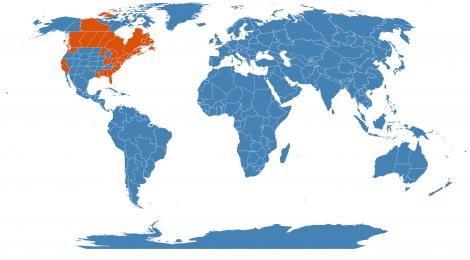Accession Data:
Sarracenia purpurea L.
- Common Name: Purple Pitcher Plant
- Family: Sarraceniaceae Dumort.
- Description: This carnivorous species is widespread in eastern USA and Canada, extending from New Jersey to the Arctic. It grows to only 6 in (15 cm) in height. The pitchers are slender at the basal rosette, rapidly becoming swollen higher up. They are usually green with purple tints and the lid stands erect. The flowers appear in spring; they are purple or greenish purple and up to 2 1/2 in (6 cm) wide. It has become naturalized in Europe, particularly Ireland.
- Culture: Cultivation: These moderately to fully frost-hardy plants need sun or part-shade and moist, peaty soil. During the growth period they need to be kept very wet, and cool and moist in winter. Propagate from seed or by division in spring.
- USDA Zone: 4a-9b
Accession Data:
- Accession # 199800089
- Source: Carolina Biological
- Accession Date: 06-08-1998
- Bench: 2310 - Temperate Carnivores
- Currently: active - healthy
- Qty: 2 confirmed on 07-21-2024
- Restrictions:
- CITES Appendix II Listed Plant
- CITES Appendix II Listed Plant
Classification:
- Division: Magnoliophyta
- Class: Magnoliopsida
- SubClass: asterids
- Order: Ericales
- SubOrder:
- Family: Sarraceniaceae
- SubFamily:
- Tribe:
- SubTribe:
Flowering Data:
This accession has been observed in bloom on:| Year | Jan | Feb | Mar | Apr | May | Jun | Jul | Aug | Sep | Oct | Nov | Dec | ||||||||||||||||||||||||||||||||||||||||
|---|---|---|---|---|---|---|---|---|---|---|---|---|---|---|---|---|---|---|---|---|---|---|---|---|---|---|---|---|---|---|---|---|---|---|---|---|---|---|---|---|---|---|---|---|---|---|---|---|---|---|---|---|
| 2024 | ||||||||||||||||||||||||||||||||||||||||||||||||||||
| 2023 | ||||||||||||||||||||||||||||||||||||||||||||||||||||
| 2022 | ||||||||||||||||||||||||||||||||||||||||||||||||||||
| 2021 | ||||||||||||||||||||||||||||||||||||||||||||||||||||
| 2020 | ||||||||||||||||||||||||||||||||||||||||||||||||||||
| 2019 | ||||||||||||||||||||||||||||||||||||||||||||||||||||
| 2018 | ||||||||||||||||||||||||||||||||||||||||||||||||||||
| 2017 | ||||||||||||||||||||||||||||||||||||||||||||||||||||
| 2016 | ||||||||||||||||||||||||||||||||||||||||||||||||||||
| 2015 | ||||||||||||||||||||||||||||||||||||||||||||||||||||
| 2014 | ||||||||||||||||||||||||||||||||||||||||||||||||||||
| 2013 | ||||||||||||||||||||||||||||||||||||||||||||||||||||
| 2012 | ||||||||||||||||||||||||||||||||||||||||||||||||||||
| 2011 | ||||||||||||||||||||||||||||||||||||||||||||||||||||
| 2010 | ||||||||||||||||||||||||||||||||||||||||||||||||||||
| 2009 | ||||||||||||||||||||||||||||||||||||||||||||||||||||
| 2008 | ||||||||||||||||||||||||||||||||||||||||||||||||||||
| 2007 | ||||||||||||||||||||||||||||||||||||||||||||||||||||
References (internal):
- Aquatic Plants
- Benthophyte
- Carnivorous Plants
- Plants with Extrafloral Nectaries
- EEB 3271 - Systematic Botany
- EEB 3203 - Developmental Plant Morphology
- Plants used in EEB 2244 - General Ecology
- Scavenger Hunt - Grades 9-12 (generic)
- ECE 2019 - Scavenger Hunt
- EEB Greenhouse Holdings native to: Northwest Territories / Alberta / British Columbia / Manitoba / Saskatchewan / Labrador / New Brunswick / Newfoundland / Nova Scotia / Ontario / Prince Edward I. / Québec / Washington / Illinois / Minnesota / Connecticut / Indiana / Maine / Masachusettes / Michigan / New Hampshire / New Jersey / New York / Ohio / Pennsylvania / Rhode I. / Vermont / West Virginia / California / Alabama / Delaware / Florida / Georgia / Louisiana / Maryland / Mississippi / North Carolina / South Carolina / Virginia / District of Columbia
References (external):
- Plants For A Future Website
- Botanica, Turner & Wasson, 1997, CD-ROM Version
- The Plant List (2013). Version 1.1. Last accessed on Thursday, September 28, 2017.
- Sarracenia purpurea at USDA/NRCS Plants Database. Last accessed on Thursday, September 28, 2017.
data regenerated on Tue, 24 Dec 2024 09:54:03 -0500 [bcm v4.0]
Images:

Additional images for this accession:
Click on thumbnails to enlargeCurrent Accessions in the Sarraceniaceae
- Sarracenia alata W/C


- Sarracenia alata W/C


- Sarracenia alata W/C


- Sarracenia flava


- Sarracenia flava var. flava W/C

- Sarracenia flava var. rubricorpa

- Sarracenia leucophylla W/C


- Sarracenia leucophylla


- Sarracenia minor

- Sarracenia minor var. okefenokeensis

- Sarracenia oreophila W/C

- Sarracenia psittacina


- Sarracenia purpurea


- Sarracenia purpurea ssp. purpurea W/C
- Sarracenia rosea 'Manmaru'

- Sarracenia rosea

- Sarracenia rubra ssp. alabamensis
- Sarracenia rubra ssp. jonesii W/C


 = indicates flowering in past 14 days
= indicates flowering in past 14 days
 = images available for this accession
= images available for this accession
 = map available for this accession
= map available for this accession
 = accession added within past 90 days
= accession added within past 90 days


